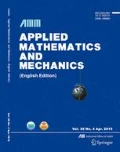Abstract
The ultra-sonic gas atomization (USGA) nozzle is an important apparatus in the metal liquid air-blast atomization process. It can generate oscillating supersonic gas efflux, which is proved to be effective to enforce the atomization and produce narrow-band particle distributions. A double-actuator ultra-sonic gas nozzle is proposed in the present paper by joining up two active signals at the ends of the resonance tubes. Numerical simulations are adopted to study the effects of the flow development on the acoustic resonant properties inside the Hartmann resonance cavity with/without actuators. Comparisons show that the strength and the onset process of oscillation are enhanced remarkably with the actuators. The multiple oscillating amplitude peaks are found on the response curves, and two kinds of typical behaviors, i.e., the Hartmann mode and the global mode, are discussed for the corresponding frequencies. The results for two driving actuators are also investigated. When the amplitudes, the frequencies, or the phase difference of the input signals of the actuators are changed, the oscillating amplitudes of gas efflux can be altered effectively.
Similar content being viewed by others
References
Hartmann, J. and Trolle, B. A new acoustic generator. Journal of Scientific Instruments, 4, 101–111 (1927)
Raman, G. and Srinivasan, K. The powered resonance tube: from Hartmann’s discovery to current active flow control applications. Progress in Aerospace Sciences, 45, 97–123 (2009)
Grant, N. J. Rapid solidification of metallic particulates. Journal of Metals, 35, 20–27 (1983)
Ayres, J. D. and Anderson, I. E. Method for Generating Fine Sprays of Molten Metal for Spray Coating and Powder Making, Patent No. 4619845, U. S.A. (1986)
Allimant, A., Planche, M. P., Bailly, Y., Dembinski, L., and Coddet, C. Progress in gas atomization of liquid metals by means of a de Laval nozzle. Powder Technology, 190, 79–83 (2009)
Zhao, W. J., Cao, F. Y., Ning, Z. L., Zhang, G. Q., Li, Z., and Sun, J. F. A computational fluid dynamics (CFD) investigation of the flow field and the primary atomization of the close coupled atomizer. Computers and Chemical Engineering, 40, 58–66 (2012)
Mullis, A. M., McCarthy, I. N., and Cochrane, R. F. High speed imaging of the flow during closecoupled gas atomization: effect of melt delivery nozzle geometry. Journal of Materials Processing Technology, 211, 1471–1477 (2011)
Rai, G., Lavernia, E. J., and Grant, N. J. Powder size and distribution in ultrasonic gas atomization. Journal of Metals, 37(8), 22–26 (1985)
Li, B., Hu, G. H., and Zhou, Z. W. Numerical simulation of flow in Hartmann resonance tube and flow in ultrasonic gas atomizer. Applied Mathematics and Mechanics (English Edition), 28(11), 1415–1426 (2007) DOI 10.1007/s10483-007-1101-6
Zhou, Z. W. and Tang, X. D. The effect of the pulsation in gas flow on the stability of melted metal jet. Fourth International Conference on Spray Forming, University of Maryland Press, Baltimore, U. S.A. (1999)
Veistinen, M. K., Lavernia, E. J., Baram, J. C., and Grant, N. J. Jet behavior in ultrasonic gas atomization. The International Journal of Powder Metallurgy, 25(2), 89–92 (1989)
Mansour, A., Chigier, N., Shih, T., and Kozarek, R. L. The effects of the Hartman cavity on the performance of the USGA nozzle needed for aluminum spray forming. Atomization and Sprays, 1, 1–24 (1998)
Wang, Z. L. Actuator Driven Ultra-Sonic Gas Atomization Nozzle, Patent No. 200810203978, P.R. China (2008)
Zu, H. B. and Wang, Z. L. Resonant behaviors of an ultra-sonic gas atomization nozzle with a zero mass-flux jet actuator. Journal of Shanghai University (English Edition), 15(3), 166–172 (2011)
Spalart, P. and Allmaras, S. A One-Equation Turbulence Model for Aerodynamic Flows, Technical Report AIAA-92-0439, American Institute of Aeronautics and Astronautics (1992)
Brocher, E., Maresca, A., and Bournay, M. H. Fluid dynamics of the resonance tube. Journal of Fluid Mechanics, 43, 369–384 (1970)
Sreejith, G. J. and Narayanan, S. Studies on conical and cylindrical resonators. Applied Acoustics, 69(12), 1161–1175 (2008)
Author information
Authors and Affiliations
Corresponding author
Additional information
Project supported by the National Natural Science Foundation of China (Nos. 10772107, 10702038, and 11172163), the E-Institutes of Shanghai Municipal Education Commission, and the Shanghai Program for Innovative Research Team in Universities
Rights and permissions
About this article
Cite this article
Zu, Hb., Zhou, Zw. & Wang, Zl. Properties of acoustic resonance in double-actuator ultra-sonic gas nozzle: numerical study. Appl. Math. Mech.-Engl. Ed. 33, 1481–1492 (2012). https://doi.org/10.1007/s10483-012-1638-x
Received:
Revised:
Published:
Issue Date:
DOI: https://doi.org/10.1007/s10483-012-1638-x


